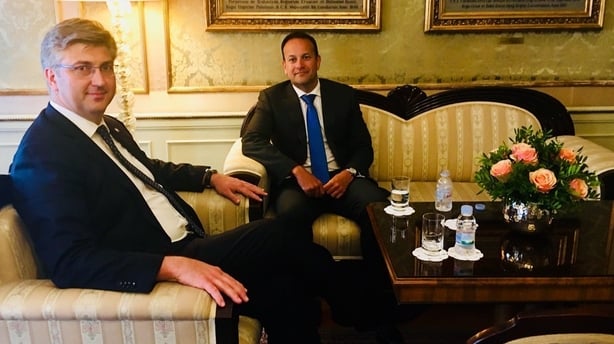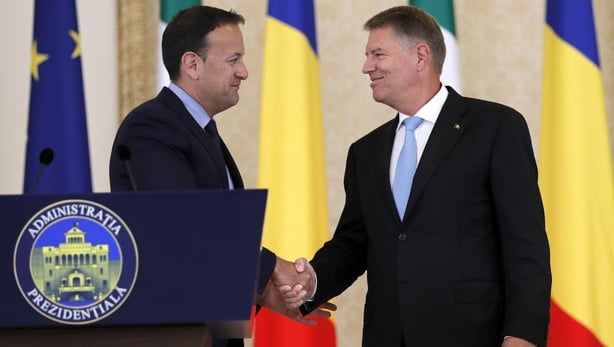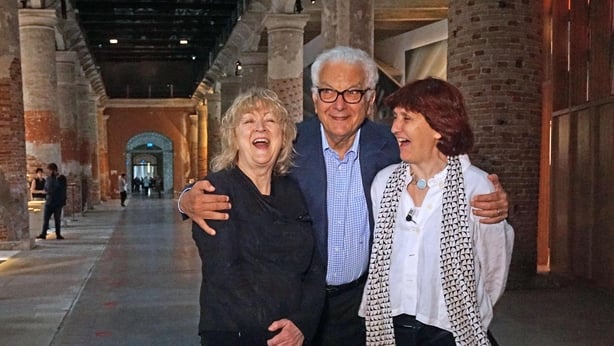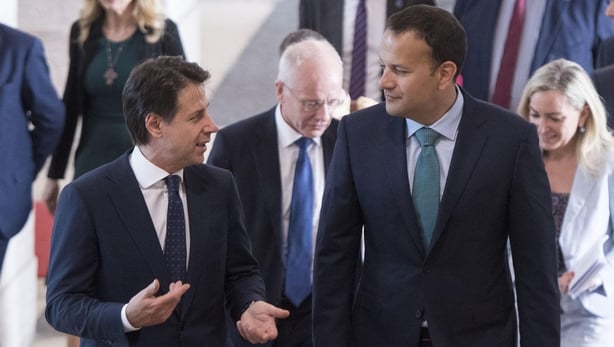The Taoiseach has a list.
On it are prime ministers of European Union member states that he aims to meet on a formal basis either in their own countries or in Ireland.
As Brexit negotiations intensify, those meetings have been prioritised by Leo Varadkar’s office.
So, as the Oireachtas wound down fully for the summer this week, the Taoiseach and his team boarded the Government jet, to reaffirm Ireland’s position on Brexit in Europe.
Political journalists took to planes, trains and buses in an effort to keep up with the whistle-stop tour.
Croatia (Monday)
Beginning in Croatia, Leo Varadkar met Prime Minister Andrej Plenkovic in Zagreb. It is not the first time they met.
They are members of the European People's Party and have had discussions at European Council meetings.
However, Monday was their first formal one-to-one discussion.

There is almost €100m of economic co-operation already between Ireland and Croatia in pharmaceuticals, IT and flight companies. However, both prime ministers agreed there could be more, through tourism, trade and education.
On Brexit, Mr Plenkovic did not hold back.
"It was always my position before the announcement of the referendum that this was a risky business and so it happened," he said.
"For me it’s a lose, lose, lose situation."
Those losses he described as manipulation of the UK electorate, the distraction of Brexit on the European project and ultimately the effect it could have on Ireland.
He committed Croatia’s full support to Ireland in the process.
Croatia and Ireland are similar in many respects and in recent years have become intertwined because of the number of Croatians that have made Ireland their home.
Romania on the other hand has seen more of its citizens move to the UK.
Romania (Tuesday)
With that in mind, in Bucharest on Tuesday, the Taoiseach and Romanian President Klaus Iohannis noted the importance of the commitment given by British Prime Minister Teresa May's government on EU citizens' rights; which includes the rights of "hundreds of thousands" of Romanians living in the UK.

The president and Prime Minister Viorica Dancila committed their support to the Taoiseach on Brexit, including no return to a hard border between Ireland and Northern Ireland.
It was probably no harm in the Irish Government securing that commitment, considering Romania will be centre stage when the Brexit deadline arrives.
It has the unenviable task of hosting the EU Presidency during March next year.
Italy - Venice (Wednesday)
It was then on to Italy where the Taoiseach stopped in Venice to see the internationally renowned Architecture Biannale which has been curated by two Irish architects, Shelley McNamara and Yvonne Farrell.

A brief respite to recharge the batteries before meeting the newly elected Italian Prime Minister Guissepe Conte in Rome.
Italy - Rome (Thursday)
Mr Conte and his government made headlines weeks ago when they denied a ship overcrowded with migrants to dock, following a toughening of Italy’s border policies to stem the flow of migrants and refugees until other EU countries stepped in to help.
While Interior Minister Matteo Salvini, who is also head of the far-right League, is regarded as the string puller on migration in the new Italian government, the issue was discussed between the Taoiseach and Prime Minister Conte, who wasn't available for a press conference or questions from the media afterwards.
Leo Varadkar said he "restated" Ireland’s "commitment or offer" made to the previous Italian government, that it would be willing to take 600 migrants from Italy to Ireland, if an appropriate security clearance could be agreed.
There was no way of questioning Mr Conte after the meeting whether that promise was enough to support the Irish Government on Brexit, but according to the Taoiseach, Giuseppe Conte understood the concerns of Ireland.

Italy may be closer to the UK geographically compared to Croatia and Romania, but it's also closer when it comes to trade - something which was not lost on the Taoiseach’s team before they met the head of the fourth largest EU economy on Thursday.
Neither has it been lost on British Prime Minister Teresa May who will spend her summer holidays in Italy, while senior cabinet members travel to other European countries in the coming weeks to promote the Chequers agreement on Brexit.
Charm offensive
So, the European Brexit charm offensive race between the British and Irish governments has begun with Mr Varadkar in front for now.
On a more serious note, his European tour is viewed as important from an Irish point of view because while the leaders of Croatia, Romania and Italy had a good awareness of Brexit; a spokesperson for the Taoiseach said some were less aware of the impact that it could have on the border.
Before returning to Ireland, Leo Varadkar said his "sense" from visiting the three countries was that "they had Ireland's back and understood Ireland's concerns".
One thing is certain - this week means that three more EU prime ministers have been ticked off his list.







